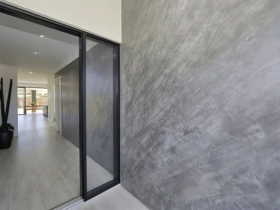In order to emphasize the grace of the room at the top between the wall and the ceiling, you can install a baguette. A rail for a stretch ceiling can be made of aluminum profile or solid PVC plastic. Modern baguettes are made of gypsum or foamed synthetic material, have more than a hundred varieties of patterns and profiles.
Preparation for the installation of baguette
PVC baguette fastening procedure is as follows. The baguette must be adjusted to the dimensions of a particular room, the excess length should be sawn down with a pendulum saw. Dubels of domestic production are suitable for fastening to the wall. The optimal dimensions are 3 cm in length, 6 cm — in diameter.
Aluminum baguette is very durable and reliable, but it has a number of disadvantages. This is a very expensive material, heavy in weight, so it is quite difficult to install it. It is not used in uneven areas, so specialists need to partially saw it, while violating the integrity of the profile. To drive self -tapping screws into it, you must first drill holes in the baguette.
The most popular is a baguette made of foamed synthetic material, since it is very easy to install. This baguette has a length of up to 3 m, which reduces the number of connections. Do not put pressure on the cutting canvas, working with a saw, as this is fraught with the formation of chips on the curb. If the chips are formed anyway, they need to be shut up with putty, although there is a chance that in the future the putty may fall off and the hole will be formed.
Installation of baguette
For this type of work, the following tools and materials will be required, such as: putty, glue for plastic, small spatula, knock, pencil.
For the proper installation of the baguette, it is necessary to draw a location diagram.
The baguette should be attached to the wall and ceiling in order to make sure there are holes between the wall and the ceiling, since the walls and ceiling are often uneven. If it turns out that there are gaps and they are large, then you need to plunge walls or ceiling in this place. If the cracks are insignificant, then they can be covered with glue, which is applied to the baguette.
With the help of a hand saw and a little, you need to cut a corner of the baguette for the incorporation of two baguettes in the corner. Next, using sandpaper, you need to clean the baguette where the cut is performed. On the edges of the baguette on both sides, it is necessary to apply glue along the entire length of the baguette.
After that, you need to dock two parts of the baguette in the inner corner, so that there are no holes between these parts, and also so that the pattern of these parts coincides. Two parts of the baguette in the outer corner are installed in the same way.
If the wall is made of drywall, you need to fix the nails into the wall in order to maintain the baguette so that it does not slide down the wall under its weight. If the wall is made of concrete or brick and it is impossible to fix the nail in it, then it is necessary to hold longer with the help of hands until the glue sticks, or fix the baguette using tape.
Then you need to remove the glue that performed between the wall or the ceiling and the baguette with your finger. With the help of small plastic spatula and special putty, it is necessary to close the joints between the baguits. After the putty dries, the joints must be cleaned with sandpaper. Adhesive tape and cellophane should close the walls of the wall and ceiling when staining the baguette so as not to bow them with paint.











Оставить коммент.